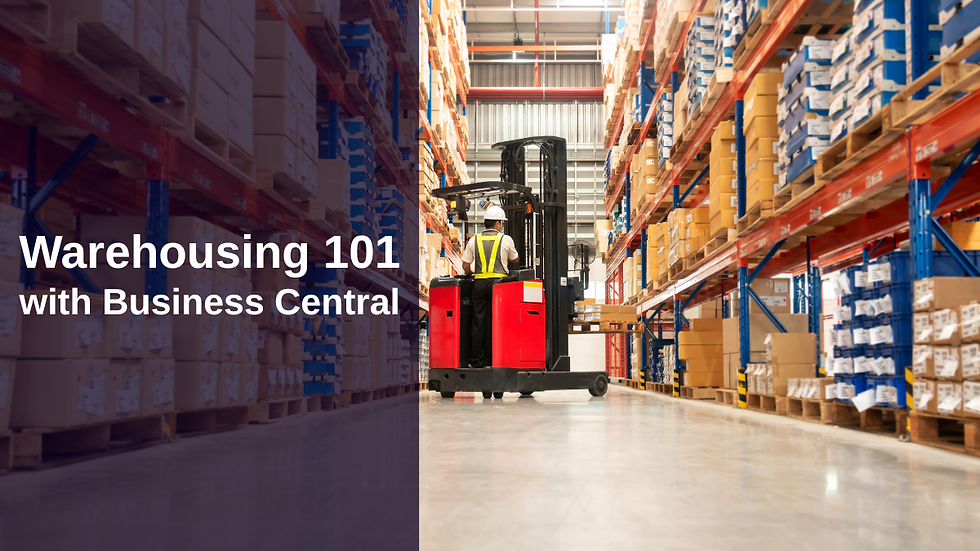Getting Warehouse Setup Right in Business Central: A Real-World Guide
- Jenn Claridge

- May 20
- 3 min read
Let’s be honest—warehousing in Business Central isn’t hard, but it can be confusing. Especially when you’re not sure whether to stick with a basic setup or dive into all the bells and whistles of advanced warehouse features.
If you’re like most companies I work with, you’re trying to find that sweet spot: just enough structure to keep things organized without making your warehouse team hate their life.
This guide is here to help you get clear on the basics, understand where advanced features make sense, and—most importantly—avoid the gotchas that catch people off guard.

What Is Warehouse Management in Business Central?
At its core, the warehouse tools in Business Central help you keep track of what’s in your building(s)—where it is, where it’s going, and who’s handling it.
You can go from no setup at all (everything just posts directly from a sales or purchase order) to fully directed picks and put-aways, where everything has to follow a formal workflow.
Here’s my rule of thumb: Start simple, but plan to scale. Warehouse setups evolve—your system should grow with your business and your people.
Basic vs. Advanced Warehouse Setup
Basic Warehouse: Keep It Simple (Until It’s Not)
A basic warehouse setup is great if:
You’ve only got one location
Your warehouse team knows where stuff is
You’re not worried about automating everything yet
It gives you:
Manual picking and shipping
Simple receiving
Some inventory visibility
But here’s the catch: most of it is manual.
No zones, no bin logic, no automation—just simple inventory movements.
Advanced Warehouse: Structure, Control, and a Lot More Documents
Advanced setup gives you:
Bins and zones
Directed picks and put-aways
Multi-location support
Real-time tracking
Two-step workflows (think: pick from bin → move to shipping)
It’s also a bit more work—more documents, more setup, more training.
That’s not a bad thing. It just means you need to match your setup to your process, not the other way around.
Lessons from the Warehouse Floor (a.k.a. Scenarios You Don’t Want to Repeat)
Scenario 1: “The Wherehouse?”
You didn’t turn on Locations. Now you can’t use planning or requisition worksheets.Planning can’t happen without knowing where stuff actually is.
Takeaway: Don’t go too basic. Location Mandatory should be turned on if you’re serious about planning.
Scenario 2: Location Mandatory
Once you start using Locations, you unlock a lot of functionality.But skip it, and you’ll hit a wall fast.
Takeaway: You need Locations to do proper planning.
Scenario 3: The Bin Dilemma
Bins help if your warehouse team is constantly asking, “Where do I find this?”They can be physical (shelves) or logical (QA complete/incomplete).Use default bins, fixed bins, or even bin ranking.
But here’s the truth: If you’re turning on Bins, commit to it—or don’t do it yet.
Inventory Docs vs Warehouse Docs
This trips up a lot of people.
Inventory Documents
Simple
Tied directly to a single sales, purchase, or production order
Posts everything in one step
Good for small teams where one person owns the flow
Warehouse Documents
Designed for two-step processes
Allow segregation of duties
Picks and put-aways are created from shipments and receipts
Give you more control (but also require more discipline)
Gotcha alert: You can’t skip steps. If you bypass a shipment, the pick won’t work. Yes—this has happened. More than once.
Real Talk on Setup: It’s Not About Turning on Everything
Scenario 5: Circumventing the Flow
If your team finds a way to skip steps… they will. This is why setup matters. You can force flows, but only if your documents and structure support it.
Don’t just ask “Can we turn on this feature?” Ask “Who’s doing this and why?”
Scenario 6–8: Warehouse Picks Gone Sideways
You created a pick, but there’s nothing to move. Why? Because the inventory was already where it was supposed to go—so BC doesn’t create a move.
These things happen when bin logic and warehouse setup aren’t aligned with your actual workflow.
More Setup = More Control = More Work
Turning on advanced warehousing adds:
More documents
More clicks
More visibility
More control
It’s amazing… if you have the structure and team to support it.
If you don’t? You’ll frustrate your users, and they’ll go back to Excel and sticky notes.
Pro tip: Ask yourself what you actually want to accomplish—not just what you can turn on.
Wrap-Up: Build It for the People Doing the Work
Warehouse setup should fit your business—not the other way around.
Ask yourself:
Who’s doing the work?
Are we trying to control or just track?
Do different users need different pages or roles?
What outcome are we trying to drive?
If you get that right, you’ll build a setup that actually works—and that people will actually use.


Comments